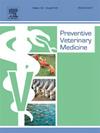Non-typhoidal Salmonella contamination of food sources from animal origin in Israel between 2007 and 2021
IF 2.2
2区 农林科学
Q1 VETERINARY SCIENCES
引用次数: 0
Abstract
Non-typhoidal Salmonella (NTS) are one of the main causes of food poisoning, a major global threat for human health. Consumption of contaminated food products of animal origin contributes to majority of the NTS illness outbreaks. Poultry, an important protein source, is considered the main animal source for NTS. However, contamination with different serotypes of NTS may be attributed to various animal hosts. We aimed to determine the prevalence, trends, and potential risk factors for NTS contamination of food sources in Israel. A dataset including 192,340 test results for the detection of NTS contamination in food products in Israel between 2007 and 2021 was analyzed. Food samples were collected as part of routine testing and targeted programs for NTS detection from different facilities, such as food factories and slaughterhouses. The collected food samples included: non-thermally treated (raw) and mainly thermally treated ready-to-eat (RTE) products. Data were summarized and associations between NTS detection and different covariates were estimated using either: (i) Poisson regression model; or (ii) ꭕ2-tests. The odds ratio (OR) or prevalence ratio and 95 % confidence intervals (CI95 %) were calculated. The number of food products tested for NTS identification and further serotype classification has declined in recent years. However, the percentage of NTS positive results increased over time, reaching 18.11 % positive samples by 2021. The risk for NTS contamination was significantly higher in raw vs. RTE products: OR (CI95 %) = 290.60 (239.39–352.76), p < 0.001. The percentage of samples found positive for NTS in RTE products varied between sources, yet remained below 0.49 % for each source. However, in raw products, the NTS prevalence ranged between 1.05 % and 35.03 %, with food products from the chicken source significantly more positively associated with NTS contamination in comparison beef, fish, pig and turkey sources. Imported food, and slaughterhouses had a significantly higher prevalence of NTS contamination compare to factories food hygiene testing. With certain facilities, within each category, demonstrating significantly higher contamination compared to others. Moreover, the ten most common serotypes reported in human infections throughout this period were mostly found in chicken and turkey sources. The identification of certain sources and facilities/importers/slaughterhouses which may pose higher risk for NTS contamination was possible despite the declining resources invested in sampling and classification of NTS isolates in recent years. Therefore, our study further emphasizes the potential and importance of establishing a real-time surveillance for better tracing of NTS contaminations in food sources to protect public health.
2007年至2021年以色列动物源性食品中非伤寒沙门氏菌污染情况
非伤寒沙门氏菌(NTS)是导致食物中毒的主要原因之一,是对人类健康的重大全球性威胁。食用受污染的动物源性食品是导致大多数NTS疾病暴发的原因。家禽是一种重要的蛋白质来源,被认为是NTS的主要动物来源。然而,不同血清型NTS的污染可能归因于不同的动物宿主。我们的目的是确定以色列食物来源中NTS污染的流行程度、趋势和潜在危险因素。分析了2007年至2021年期间以色列食品中NTS污染检测的192340个测试结果的数据集。从食品工厂和屠宰场等不同设施收集食品样品,作为常规检测和NTS检测目标项目的一部分。收集的食物样本包括:未经热处理(生)和主要经热处理的即食产品。对数据进行总结,并使用泊松回归模型估计NTS检测与不同协变量之间的关联;或(ii)ꭕ2个测试。计算比值比(OR)或患病率和95 %可信区间(CI95 %)。近年来,接受NTS鉴定和进一步血清型分类的食品数量有所下降。然而,随着时间的推移,NTS阳性结果的百分比增加,到2021年达到18.11% 阳性样本百分比。原料产品中NTS污染的风险明显高于RTE产品:OR (CI95 %)= 290.60 (239.39-352.76),p <; 0.001。在RTE产品中发现NTS阳性的样品百分比因来源而异,但每个来源均低于0.49 %。然而,在原料产品中,NTS患病率介于1.05 %和35.03 %之间,与牛肉、鱼、猪和火鸡来源的食品相比,鸡肉来源的食品与NTS污染的关系更为密切。进口食品和屠宰场的NTS污染率明显高于工厂食品卫生检测。在每个类别中,某些设施的污染程度明显高于其他设施。此外,在这一时期报告的人类感染中最常见的10种血清型主要来自鸡肉和火鸡。尽管近年来在NTS分离物取样和分类方面投入的资源有所减少,但仍有可能确定可能对NTS污染构成较高风险的某些来源和设施/进口商/屠宰场。因此,我们的研究进一步强调了建立实时监测的潜力和重要性,以便更好地追踪食物来源中的NTS污染,以保护公众健康。
本文章由计算机程序翻译,如有差异,请以英文原文为准。
求助全文
约1分钟内获得全文
求助全文
来源期刊

Preventive veterinary medicine
农林科学-兽医学
CiteScore
5.60
自引率
7.70%
发文量
184
审稿时长
3 months
期刊介绍:
Preventive Veterinary Medicine is one of the leading international resources for scientific reports on animal health programs and preventive veterinary medicine. The journal follows the guidelines for standardizing and strengthening the reporting of biomedical research which are available from the CONSORT, MOOSE, PRISMA, REFLECT, STARD, and STROBE statements. The journal focuses on:
Epidemiology of health events relevant to domestic and wild animals;
Economic impacts of epidemic and endemic animal and zoonotic diseases;
Latest methods and approaches in veterinary epidemiology;
Disease and infection control or eradication measures;
The "One Health" concept and the relationships between veterinary medicine, human health, animal-production systems, and the environment;
Development of new techniques in surveillance systems and diagnosis;
Evaluation and control of diseases in animal populations.
 求助内容:
求助内容: 应助结果提醒方式:
应助结果提醒方式:


